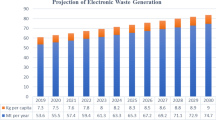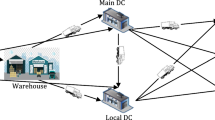Abstract
As policies and regulations related to environmental protection and resource constraints are becoming increasingly tougher, corporations may face the difficulty of determining the optimal trade-offs between economic performance and environmental concerns when selecting product technology and designing supply chain networks. This paper considers weight reduction technology selection and network design problem in a real-world corporation in China which produces, sells and recycles polyethylene terephthalate (PET) bottles used for soft drinks. The problem is addressed while taking consideration of future regulations of carbon emissions restrictions. First, a deterministic mixed-integer linear programming model is developed to analyze the influence of economic cost and carbon emissions for different selections in terms of the weight of PET bottle, raw material purchasing, vehicle routing, facility location, manufacturing and recycling plans, etc. Then, the robust counterpart of the proposed mixed-integer linear programming model is used to deal with the uncertainty in supply chain network resulting from the weight reduction. Finally, results show that though weight reduction is both cost-effective and environmentally beneficial, the increased cost due to the switching of the filling procedure from hot-filling to aseptic cold-filling and the incumbent uncertainties have impacts on the location of the Pareto frontier. Besides, we observe that the feasible range between economic cost and carbon emission shrinks with weightreduction; and the threshold of restricted volume of carbon emission decreases with the increase of uncertainty in the supply chain network.

Source: Euronmonitor International






Similar content being viewed by others
Abbreviations
- t :
-
The index of operational periods \(t=1,\ldots , T\)
- i :
-
The index of potential new PET chips suppliers \(i =1,\ldots ,I\)
- j :
-
The index of potential manufacturing centers \(j=1,\ldots , J\)
- k :
-
The index of potential distribution center locations \(k=1,\ldots ,K\)
- m :
-
The index of potential recycling center locations \(m=1,\ldots ,M\)
- n :
-
The index of markets \(n =1,\ldots , N\)
- \({PN}_{ijt}\) :
-
The quantity of new PET chips in manufacturing center j provided by supplier i in period t
- \({MD}_{jkt}\) :
-
The quantity of PET bottles shipped from manufacturing center j to distribution center k in period t
- \({DX}_{knt}\) :
-
The quantity of PET bottles shipped from distribution center k to market n in period t
- \({RX}_{mnt}\) :
-
The quantity of returned PET bottles recycled from market n to recycling center m in period t
- \({MR}_{jmt}\) :
-
The quantity of recovered PET chip from recycling center m to manufacturing center j in period t
- \(S_{i}\) :
-
\(=\left\{ {\begin{array}{ll} {1} &{} \hbox {If a new PET chips supplier } i \hbox { is opened,}\\ {0} &{} \hbox { Otherwise,}\end{array}} \right. \)
- \({MC}_{j}\) :
-
\(=\left\{ {\begin{array}{ll} {1} &{} \hbox { If a manufacturing center }j\hbox { is opened, }\\ 0 &{} \hbox { Otherwise,}\\ \end{array}} \right. \)
- \({DC}_{k}\) :
-
\(=\left\{ {\begin{array}{ll} {1} &{} \hbox { If a distribution center }k \hbox { is opened, }\\ {0} &{} \hbox {Otherwise,}\\ \end{array}} \right. \)
- \({RC}_{m}\) :
-
\(=\left\{ {\begin{array}{ll} 1 &{} \hbox {If a recycling center }m\hbox { is opened, }\\ 0 &{} \hbox {Otherwise,}\\ \end{array} }\right. \)
- \(\theta _{t}\) :
-
Average recovery rate in period t
- \(\sigma _{mt}\) :
-
Discard rate of unusable recycling PET chips at recycling center m in period t
- \(\gamma \) :
-
Conversion coefficient from chips to a bottle
- \(\omega \) :
-
Ratio of recovered chips contained in a bottle
- \(\mathrm {\Delta }\) :
-
Net weight of water contained in a bottle
- \(d_{nt}\) :
-
Demand of market n in period t
References
Abdallah, T., Diabat, A., & Simchi-Levi, D. (2012). Sustainable supply chain design: A closed-loop formulation and sensitivity analysis. Production Planning and Control, 23(2–3), 120–133.
Ben-Tal, A., Golany, B., Nemirovski, A., & Vial, J. P. (2005). Retailer-supplier flexible commitments contracts: A robust optimization approach. Manufacturing and Service Operations Management, 7(3), 248–271.
Bertsimas, D., & Sim, M. (2004). The price of robustness. Operations Research, 52(1), 35–53.
Bojarski, A. D., Laínez, J. M., Espuna, A., & Puigjaner, L. (2009). Incorporating environmental impacts and regulations in a holistic supply chains modeling: An LCA approach. Computers and Chemical Engineering, 33(10), 1747–1759.
Chaabane, A., Ramudhin, A., & Paquet, M. (2012). Design of sustainable supply chains under the emission trading scheme. International Journal of Production Economics, 135(1), 37–49.
Chen, C. (2001). Design for the environment: A quality-based model for green product development. Management Science, 47(2), 250–263.
Chiang, T. A., & Che, Z. H. (2015). A decision-making methodology for low-carbon electronic product design. Decision Support Systems, 71, 1–13.
Chiu, C. H., & Choi, T. M. (2016). Supply chain risk analysis with mean-variance models: A technical review. Annals of Operations Research, 240(2), 489–507.
Chiu, M. C., & Chu, C. H. (2012). Review of sustainable product design from life cycle perspectives. International Journal of Precision Engineering and Manufacturing, 13(7), 1259–1272.
Cholette, S., & Venkat, K. (2009). The energy and carbon intensity of wine distribution: A study of logistical options for delivering wine to consumers. Journal of Cleaner Production, 17(16), 1401–1413.
Dong, C., Shen, B., Chow, P. S., Yang, L., & Ng, C. T. (2016). Sustainability investment under cap-and-trade regulation. Annals of Operations Research, 240(2), 509–531.
Euromonitor International. http://www.euromonitor.com/soft-drinks.
Evans, L., Lohse, N., & Summers, M. (2013). A fuzzy-decision-tree approach for manufacturing technology selection exploiting experience-based information. Expert Systems with Applications, 40(16), 6412–6426.
Fahimnia, B., Sarkis, J., Dehghanian, F., Banihashemi, N., & Rahman, S. (2013). The impact of carbon pricing on a closed-loop supply chain: An Australian case study. Journal of Cleaner Production, 59(18), 210–225.
Fattahi, M., Mahootchi, M., & Husseini, S. M. M. (2016). Integrated strategic and tactical supply chain planning with price-sensitive demands. Annals of Operations Research, 242(2), 423–456.
FrotaNeto, J. Q., Bloemhof-Ruwaard, J. M., van Nunen, J. A. E. E., & van Heck, E. (2008). Designing and evaluating sustainable logistics networks. International Journal of Production Economics, 111(2), 195–208.
Govindan, K., & Sivakumar, R. (2016). Green supplier selection and order allocation in a low-carbon paper industry: Integrated multi-criteria heterogeneous decision-making and multi-objective linear programming approaches. Annals of Operations Research, 238(1), 1–34.
Iyengar, G. N. (2005). Robust dynamic programming. Mathematics of Operations Research, 30(2), 257–280.
Jamdar, V., Kathalewar, M., Dubey, K. A., & Sabnis, A. (2017). Recycling of PET wastes using electron beam radiations and preparation of polyurethane coatings using recycled material. Progress in Organic Coatings, 107(2017), 54–63.
Kuo, T. C., Chen, H. M., Liu, C. Y., Tu, J. C., & Yeh, T. C. (2014). Applying multi-objective planning in low-carbon product design. International Journal of Precision Engineering and Manufacturing, 15(2), 241–249.
Lalmazloumian, M., Wong, K. Y., Govindan, K., & Kannan, D. (2016). A robust optimization model for agile and build-to-order supply chain planning under uncertainties. Annals of Operations Research, 2, 1–36.
Leung, S. C. H., Tsang, S. O. S., Ng, W. L., & Wu, Y. (2007). A robust optimization model for multi-site production planning problem in an uncertain environment. European Journal of Operational Research, 181(1), 224–238.
Li, X., & Zhu, D. (2011). Object technology software selection: A case study. Annals of Operations Research, 185(1), 5–24.
Mavrotas, G. (2009). Effective implementation of the \(\varepsilon \)-constraint method in multi-objective mathematical programming problems. Applied Mathematics and Computation, 213(2), 455–465.
Mulvey, J. M., Vanderbei, R., & Zenios, S. (1995). Robust optimization of large-scale systems. Operations Research, 43(2), 264–280.
Nouira, I., Hammami, R., Frein, Y., et al. (2016). Design of forward supply chains: Impact of a carbon emissions-sensitive demand. International Journal of Production Economics, 173, 80–98.
Pan, S., Ballot, E., & Fontane, F. (2013). The reduction of greenhouse gas emissions from freight transport by pooling supply chains. International Journal of Production Economics, 143(1), 86–94.
Petridis, K. (2015). Optimal design of multi-echelon supply chain networks under normally distributed demand. Annals of Operations Research, 227(1), 63–91.
Pishvaee, M. S., Rabbani, M., & Torabi, S. A. (2011). A robust optimization approach to closed-loop supply chain network design under uncertainty. Applied Mathematical Modelling, 35(2), 637–649.
Ramudhin, A., Chaabane, A., & Paquet, M. (2010). Carbon market sensitive sustainable supply chain network design. International Journal of Management Science and Engineering Management, 5(1), 30–38.
Ravi, S., Sudheer, G., & Brian, T. (2009). Product design and supply chain coordination under extended producer responsibility. Production and Operations Management, 18(3), 259–277.
Sabri, E. H., & Beamon, B. M. (2000). A multi-objective approach to simultaneous strategic and operational planning in supply chain design. Omega, 28(5), 581–598.
Soyster, A. (1973). Convex programming with set-inclusive constraints and applications to inexact linear programming. Operations Research, 21(5), 1154–1157.
Steele, L. W. (1989). Managing technology: The strategic view. New York: McGraw-Hill.
Stranlund, J. K. (2007). The regulatory choice of noncompliance in emissions trading programs. Environmental and Resource Economics, 38(1), 99–117.
Taki, P., Barzinpour, F., & Teimoury, E. (2016). Risk-pooling strategy, lead time, delivery reliability and inventory control decisions in a stochastic multi-objective supply chain network design. Annals of Operations Research, 244(2), 1–28.
Yu, C. S., & Li, H. L. (2000). A robust optimization model for stochastic logistics problems. International Journal of Production Economics, 64(1–3), 385–397.
Acknowledgements
This work described in this paper was partially supported by National Scientific Foundation of China (Project No. 71671152 Grant No. 61750110536),Guangdong Natural Science Foundation fund (2015A030313782), SUSTech Startup fund (Y01236215), National Scientific Foundation of Fujian Province (Project No. 2015J01288), the Program for New Century Excellent Talents in University (NCET-12-0321) andthe Fundamental Research Funds for the Central Universities (No. 20720151004).
Author information
Authors and Affiliations
Corresponding author
Appendices
Appendix: Related parameters
Other parameters | |
|---|---|
\(\bar{msc}_{it}\) | Maximal supply capacity of new PET chips from supplier i in period t |
\(\bar{mmc}_{jt}\) | Maximal production capacity of PET bottles at manufacturing center j in period t |
\(\bar{mdc}_{kt}\) | Maximal distribution capacity of PET bottles at distribution center k in period t |
\(\bar{mrc}_{mt}\) | Maximal processing capacity of returned PET bottles at recycling center k in period t |
\({fs}_{i}\) | Fixed cost of selecting supplier i to establish a long-term business |
\({fm}_{j}\) | Fixed cost of opening manufacturing center j |
\({fd}_{k}\) | Fixed cost of opening distribution center k |
\({fr}_{m}\) | Fixed cost of opening recycling center m |
\({ps}_{ijt}\) | Unit purchase price of new PET chips from supplier i to manufacturing center j in period t |
\({pp}_{kt}\) | Unit processing cost in distribution center k |
\({pr}_{mnt}\) | Unit repurchase price of returned PET bottles from market n torecycling center m in period t |
\({pt}_{t}\) | Unit cost of delivering cargoes (chips or bottles) per unit weight per unit distance in period t |
\({pd}_{mt}\) | Unit cost of discarding unusable recycling PET chips at recycling center m in period t |
\({prr}_{mt}\) | Unit cost of regenerating recovery PET chips at recycling center m in period t |
\({lsm}_{ij}\) | Shortest shipping distances from supplier i to manufacturing center j |
\({lmd}_{jk}\) | Shortest shipping distances from manufacturing center j to distribution center k |
\({ldx}_{kn}\) | Shortest shipping distances from distribution center k to market n |
\({lxr}_{nm}\) | Shortest shipping distances from market n torecycling center m |
\({lrm}_{mj}\) | Shortest shipping distances from recycling center m to manufacturing center j |
\({cn}_{ijt}\) | Unit carbon emission of purchasing new PET chips from supplier i to manufacturing center j in period t |
\({crr}_{mt}\) | Unit carbon emission of regenerating recovery PET chips at recycling center m in period t |
\({crd}_{mt}\) | Unit carbon emission of discarding unusable recycling PET chips at recycling center m in period t |
\({ct}_{t}\) | Unit carbon emission of delivering cargoes (chips or bottles) per unit weight per unit distance in period t |
Appendix: Related data
See Tables 2, 3, 4, 5, 6 and 7.
Rights and permissions
About this article
Cite this article
Han, S., Jiang, Y., Zhao, L. et al. Weight reduction technology and supply chain network design under carbon emission restriction. Ann Oper Res 290, 567–590 (2020). https://doi.org/10.1007/s10479-017-2696-8
Published:
Issue Date:
DOI: https://doi.org/10.1007/s10479-017-2696-8




